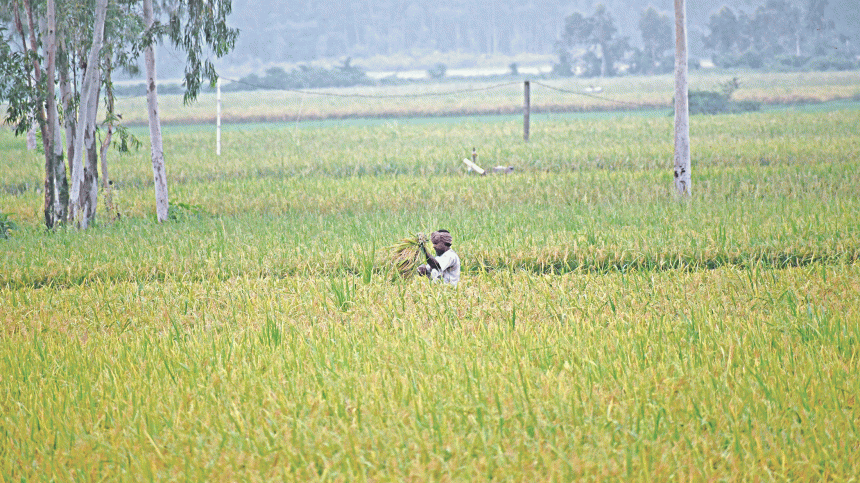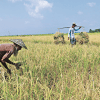Bangladesh’s rice acreage, production to drop

Land use for rice cultivation in Bangladesh is likely to decline in marketing year (MY) 2023-24, which began on May, forecasted the US Department of Agriculture at the end of last week.
The late arrival of monsoon rains and a heatwave during the Aus season may result in rice cultivation area being 1.7 percent lower to 1.16 crore (one crore = 10 million) hectares of land than the 1.18 crore hectares it had previously forecasted, said the USDA.
Accordingly, total milled rice production is expected to decline to 3.64 crore tonnes, down 1.6 percent from its earlier prediction of 3.7 crore tonnes.
There was 16 per cent lower rainfall than the average in June whereas nearly 51 percent below normal in July. Monsoon rains are likely to be normal in August, forecasted Bangladesh Meteorological Department earlier this month.
"The reduction is due to the decrease in acreage and production of the last Aus season rice and current Aman season rice," said the USDA in its latest Grain and Feed Update on Bangladesh.
There was 16 per cent lower rainfall than the average in June whereas nearly 51 percent below normal in July. Monsoon rains are likely to be normal in August.
The agency considers Boro, the dry season crop requiring irrigation, to be the first rice season for the marketing year.
And in the MY24, production of the Boro rice, planted between December 2022 and January 2023 and harvested from April to May, was 2 crore tonnes, it added.
The Bangladesh Bureau of Statistics is yet to publish its estimate on the production of Boro rice.
The Aus rice is the second crop in the marketing year and its cultivation starts from the March-April period whereas harvests from July to August.
The USDA report, citing estimates by the Department of Agricultural Extension (DAE) and agricultural officials, said lower rainfall and a heatwave hampered the Aus season rice cultivation in many areas of the country this year.
As a result, the area coming under Aus season rice cultivation declined to 10.5 lakh hectares of land, down 5 percent from its previous forecast.
Production of the crop is expected to fall 4 percent to 24 lakh tonnes as well, it said, adding that the crop heavily depends on rainfall and contributes less than 10 percent of the annual rice production.
Adequate and timely rains are important for good yields of the post-monsoon Aman season rice, whose seedling are grown in seedbeds prepared early July and which are transplanted in the August-September period, said the report.
Delayed monsoon rains and a lack of rainfall in July affected the preparation of seedbeds for the Aman rice this season, said the US agency.
Farmers adopted to supplemental irrigation to prepare and flood their lands for the transplantation of seedlings. The costs of irrigation vary for each farmer, but it is Tk 2,000 per acre (0.4 hectares) on an average, it said.
The USDA has lowered its forecast for the MY24 Aman season rice cultivation area and production by 3 percent and 4 percent to 57.5 lakh hectares of land and 1.40 crore tonnes respectively.
With lower production, the agency revised upward its forecast of rice imports by Bangladesh to 10 lakh tonnes from a previous 900,000 tonnes.
In terms of consumption of rice, the staple food in Bangladesh, the US agency said overall consumption of the grain may slightly decline to 3.8 crore tonnes in the MY24 from its previous forecast of 3.82 crore tonnes for the lower production of rice production.
The agency also highlighted the issue of production costs increasing for farmers. Citing its contacts, the USDA report said currently farmers were using both chemical and organic fertilisers for Aman rice cultivation.
There is no shortage of chemical fertilisers this season, it said.
"However, farmers are paying slightly higher prices than the government rate to buy chemical fertilisers," said the USDA referring to its contacts.
Farmers' profits from rice cultivation are getting lower as costs of inputs, including seeds, fertilisers, herbicides and pesticides, are increasing, said the report.
"Moreover, higher labour costs also affect the total cost of rice production. The cost of irrigation has also gone up recently due to higher fuel prices," it said.
"By having to use supplemental irrigation during what is normally a rainfed rice season is also increasing the cost of production," it said.

 For all latest news, follow The Daily Star's Google News channel.
For all latest news, follow The Daily Star's Google News channel. 







Comments